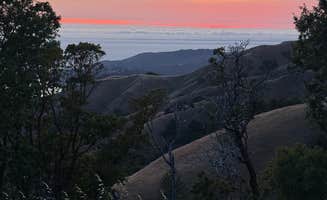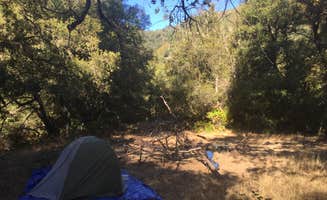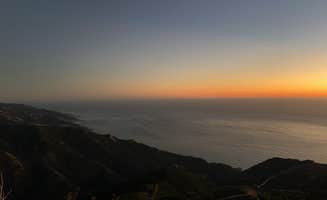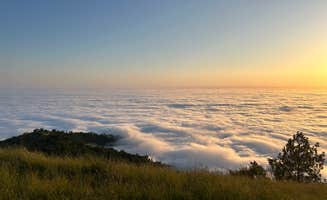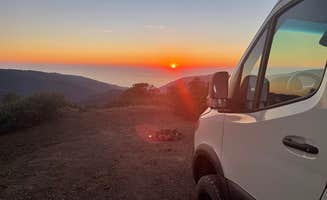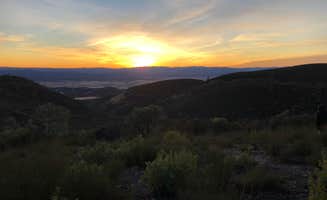Dispersed camping near Big Sur, California primarily occurs on lands managed by the U.S. Forest Service and Bureau of Land Management. Primitive sites range in elevation from 1,500 to 5,000 feet, offering camping options above the marine layer that often blankets the coast. Summer temperatures at these higher elevations typically reach 75-85°F during daytime hours but can drop significantly at night, creating a 30-40 degree temperature differential between day and night.
What to do
Backcountry hiking and camping: Access Timber Top Camp via a 2.8-mile trail for primitive camping experiences. "This might be the most beautiful camping spot I have ever stayed at. It's a ~2.8 mile hike in, but it is worth every step. Almost every hill top has a campsite, there is so many opportunities for stays," reports one visitor to Timber Top Camp.
Backpacking along river trails: The Carmel River Trail offers multiple backcountry camping options. According to one backpacker at Bluff Camp: "This is backcountry backpacking, so: no potable water - bring a filter, pack in pack out trash, fires may be restricted, no restrooms or other facilities, lots of poison oak, trail may be impassable at some points."
Stargazing from ridge viewpoints: Clear nights at higher elevations provide exceptional astronomical viewing. A camper at Plasket Ridge noted: "Amazing location to wake up in the morning. View of the pacific ocean on one side and valley on the other. 4x4 vehicle needed. Fairly safe, clean, and not crowded."
What campers like
Sunset and sunrise views: The elevated positions of most dispersed sites provide dramatic morning and evening vistas. A camper at Plasket Ridge Dispersed Campground reported: "This was a perfect campground for Big Sur, just past the Plaskett Creek campground which is expensive and requires reservations. I drove up the road for about 20 minutes and found a perfect pullout overlooking the ocean between two apple trees."
Privacy and space: Many sites offer more solitude than developed campgrounds, especially on weekdays. "We towed our 30' travel trailer up to this dispersed campground that is located along a ridge line on the west side of the 101. When we went, of the (7) formal sites that are up there, only 3 of them were taken and that was off and on," noted a visitor to Williams Hill Recreation Area.
Free camping options: Cost-conscious travelers appreciate the no-fee areas. "Slightly bumpy dirt road to get to the campsites, but easy enough to follow. We camped here with a rooftop tent and had no difficulty parking. There were only two other campers there - 1 tent and 1 RV," explains one camper at Williams Hill Recreation Area.
What you should know
Fire restrictions: Seasonal bans on open fires are strictly enforced. A local director with the Big Sur Community Association warns: "Hey campers! If you're planning to visit the Big Sur Coast this summer, just a heads up: campfires are NOT permitted outside of established campgrounds during the summer months. This is crucial to prevent forest fires, which we've struggled with in the past."
Road conditions: Access roads vary significantly in quality and difficulty. A visitor to Plasket Ridge described: "Only when desperate... Every campsite within an hour range of Big Sur was full, and it was getting dark so we opted for this road. It is the only road where dispersed camping is allowed but beware: it is narrow, steep, unmaintained, and surrounded by cliffs."
Seasonal closures: Several primitive camping roads close periodically. Recent reports from Will Creek Road indicate: "Attempted to camp on 12/01/2024 and the road was closed. Beautiful views on the way, but unfortunately the gate was locked," and another noted: "Mid July - road was closed."
Tips for camping with families
Site selection priorities: Choose locations with level ground and natural boundaries. "Quiet, easy to locate spot... Beautiful sunrise off the hill in the morning and plenty of birds hanging out to watch while making our camp breakfast," reports a family at Williams Hill.
Insect preparation: Pack appropriate repellents and clothing, especially during warmer months. According to a visitor at Cone Peak: "This was one of the most beautiful backpacking hikes I've ever done, but also one of the more challenging ones to do in one day. 11.1 miles from trail head to the summit. 5,600 ft. in elevation gain."
Water planning: No potable water exists at dispersed sites, requiring careful planning. "The view is amazing!! I would recommend driving up the mountain through Lockwood, the drive is much easier and less scary. We arrived around 5:30pm (end of march) and there was only 1 spot left," notes a camper at Williams Hill.
Tips for RVers
Size limitations: Most dispersed areas accommodate smaller rigs only. One Williams Hill camper warned: "7 mile dirt road at times a bit steep and rough. But we made it up here slowly and safely. A few other campers here. Some flies but a slight breeze that will hopefully keep them at bay. Nice spot just not a fan of taking a 27 foot 1996 RV up that road."
Amenities overview: Limited facilities require self-sufficiency. "Each of the (7) sites had a concrete pad with a covered picnic table and a BBQ pit! Please pick up your trash if you go. There was some beer cans and other garbage left behind by some mental midgets," reports a Williams Hill visitor.
Time-of-day arrival: Earlier arrival improves site selection options. "This is a nice area and it's free so you can't beat that. Unfortunately there aren't a ton of spots to camp. I've been twice now and both times the actual camp sites were full by the time I got there (2-3pm Friday). Leaving us to grab one of the few remaining dispersed spots," explains one camper at Williams Hill Recreation Area.


